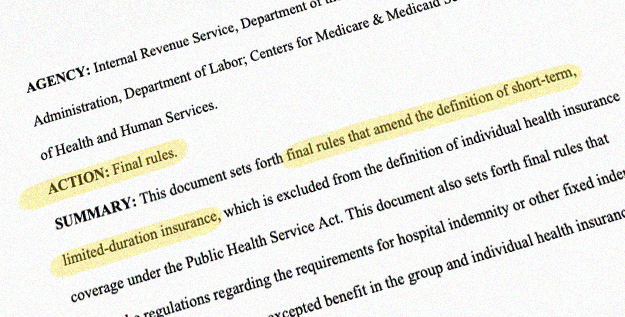
EDIT, November 22, 2021: The Build Back Better Act would temporarily extend the extra financial assistance for people receiving unemployment compensation. The bill has been through several iterations, but the version that passed the House in November (see Section 30605) calls for the extra subsidies to be available through the end of 2022, for people who receive unemployment compensation for at least one week in 2022. The legislation would increase the income disregard threshold to 150% of the poverty level, but that would still result in full premium subsidies and full cost-sharing reductions for eligible enrollees.
EDIT, November 9, 2021: The IRS published the draft version of the 2021 instructions for Form 8962. They clarify that there will simply be a box you can check in Part I, Line A, indicating that you received unemployment compensation at some point in 2021. Your income for subsidy eligibility purposes will then be modified as described below, allowing you to claim the premium tax credit on your tax return if you didn’t have it paid on your behalf in real-time during the year. For people who had marketplace coverage for the entire year, this is how the extra premium tax credit for the first several months of the year will be claimed, since they didn’t roll out in real-time in most states until July.
EDIT, September 17, 2021: Although the COVID/American Rescue Plan special enrollment window on HealthCare.gov ended in mid-August, consumers who are receiving or have received unemployment compensation in 2021 can still enroll in coverage and take advantage of the premium subsidies and cost-sharing reductions described in this article.
This special enrollment period does not show up on HealthCare.gov’s SEP prescreener, but the marketplace will review applications weekly to identify applicants who have received unemployment compensation. They will then reach out to those applicants to let them know that their special enrollment period has been approved.
If you’re in a state that uses the HealthCare.gov marketplace, you’ve received unemployment compensation this year, and you’re not eligible for Medicaid, Medicare, or another employer’s health plan, it’s in your best interest to begin the process of enrolling in a 2021 plan, as access to the American Rescue Plan benefits is still available to you.
If you’re in a state that runs its own marketplace, you may find that a similar provision is being offered, or you may find that your state’s marketplace has an ongoing COVID/American Rescue Plan enrollment window that you can use to sign up and take advantage of the unique benefits available to you in 2021.
________________________________________________________
Although the American Rescue Plan (ARP) is about far more than just healthcare, it’s the most significant improvement to healthcare access and affordability since the Affordable Care Act.
Obamacare subsidy calculator *
Estimated annual subsidy
$0
We’ve already talked about how the new law – passed by Congress this week and signed by President Biden today – will boost premium subsidies for most marketplace enrollees in 2021 and 2022 and also protect people from having to repay excess premium subsidies from last year.
But another important provision in the legislation will provide substantial premium tax credits (premium subsidies) and cost-sharing reductions to Americans who are receiving unemployment benefits at any time this year.
EDIT: The specifics of the additional financial assistance are detailed below. CMS has confirmed that the additional health insurance subsidies for people receiving unemployment compensation in 2021 will be available on HealthCare.gov as of July 2021. HealthCare.gov is used in 36 states. The other states, which run their own marketplaces, are debuting this benefit on varying schedules as their software and systems allow (ranging from as early as March 29 in DC, to as late as July or August in several states).
The premium subsidies are retroactive to the start of the year, so people who receive unemployment compensation this year will be able to claim the additional subsidies for the first several months of the year when they file their 2021 tax returns (assuming they were enrolled in marketplace coverage during that time). But eligibility for robust cost-sharing reductions will depend on the marketplace being able to disregard income over 133% of the poverty level for people who are receiving unemployment compensation, and that won’t be available until the summer in most states.
Full premium subsidies + strongest level of cost-sharing reductions
Section 9663 of the American Rescue Plan ensures that most people who receive at least one week of unemployment compensation at any time in 2021 will be able to obtain a Silver plan with $0 premiums. And Section 2305 ensures that the Silver plan will also include cost-sharing reductions that bring the actuarial value of the plan to 94% (which is superior to the actuarial value of a Platinum plan).
In both cases – for determining the premium tax credit amount and cost-sharing reduction eligibility – the exchange will disregard any income above 133% of the poverty level.
The enhanced premium subsidies in the American Rescue Plan result in $0 benchmark plan premiums for buyers with income up to 150% of the federal poverty level. So people receiving unemployment compensation will end up in that category, since their counted income will be capped at 133% of the poverty level.
(Note that there are some states that require abortion coverage on all plans, and some states where all of the insurers voluntarily include abortion coverage in their plans. In these states, after-subsidy premiums cannot be less than $1/month, and are sometimes slightly higher than that. Nothing about this has changed with the American Rescue Plan, which means that there are a few states where people receiving unemployment compensation in 2021 will still pay a nominal premium for a silver plan.)
And although there are three levels of cost-sharing reductions, the strongest – which result in added benefits that make Silver plans more robust than regular Platinum plans – are available to people who earn no more than 150% of FPL. Since counted income will be capped at 133% of the poverty level for people receiving unemployment compensation, all of the available Silver plans will have the strongest level of cost-sharing reductions built into their benefits.
In order to qualify for the enhanced premium tax credits and cost-sharing reductions, applicants only need to receive (or be approved to receive) unemployment compensation for at least one week in 2021. The legislation states that eligible enrollees will have to attest to the fact that they’re receiving or have received unemployment compensation this year, and that HHS will issue guidance clarifying what documentation will have to be submitted to the marketplace as proof.
The enhanced premium subsidies and cost-sharing reduction benefits are then potentially available for the remainder of 2021. But this will depend on whether you again become eligible for employer-sponsored health insurance that’s considered affordable and provides minimum value.
If you do, you’ll no longer be eligible for premium subsidies or cost-sharing reductions, since those are never available for months that a person is eligible for affordable employer-sponsored coverage that provides minimum value (regardless of whether the person is enrolled in the employer’s plan or not). That would also extend to family members who are eligible to enroll in the employer-sponsored plan, as the American Rescue Plan does not, unfortunately, address the family glitch.
Provides assistance to people who would otherwise be in the Medicaid coverage gap
Under the ARP, a person who receives unemployment compensation in 2021 is considered an “applicable taxpayer” for purposes of ACA Section 36B, which determines premium subsidy eligibility.
This means that a person who is receiving unemployment compensation but whose income is still low enough to be in the Medicaid coverage gap would be eligible for a $0 premium silver plan in 2021 (The Medicaid coverage gap still exists in 14 states; this will drop to 12 states once Oklahoma and Missouri expand Medicaid eligibility this summer.)
The ARP also encourages those remaining states to expand Medicaid. It provides two years of additional federal Medicaid funding to states that newly expand eligibility as called for in the Affordable Care Act.
Enrollment window is opportunity to take advantage of subsidies
From now through August 15, Americans can take advantage of an enrollment window that’s part of the Biden administration’s efforts to address the ongoing COVID pandemic (note that some states that run their own exchanges — as opposed to using HealthCare.gov — have different rules and deadlines for their COVID-related enrollment window in 2021). So if you’re uninsured and receiving unemployment benefits (or if you’ve received them at any point this year and do not have access to an employer-sponsored plan), you can sign up for health coverage through your state’s marketplace and take advantage of the financial assistance provided by the American Rescue Plan.
In nearly every state, people who are already enrolled in a health plan through the marketplace can also use this window to switch plans.
But what if you’re in a state with a state-run marketplace that is only allowing people who don’t already have marketplace coverage to enroll during the COVID-related enrollment window? You should still be able to switch to a Silver plan (if that’s your choice), as becoming newly eligible for cost-sharing reductions is a qualifying event that will allow you to replace your existing non-Silver plan with a Silver plan that includes cost-sharing reductions.
What if you’re eligible for Medicaid?
It’s important to understand that Medicaid eligibility is not affected by the change in how income is counted for people who are receiving unemployment compensation this year.
ARP Section 9663 temporarily adjusts the rules relating to ACA Section 36B (premium tax credits) and ARP Section 2305 temporarily adjusts the rules relating to ACA Section 1402 (cost-sharing reductions). In both cases, the legislative text that disregards income above 133% of FPL for 2021 is clear in noting that it’s “for purposes of this section,” meaning that the person’s income above 133% of FPL would not be disregarded for other purposes, such as determining Medicaid eligibility, Basic Health Program eligibility (in New York and Minnesota), or whether an offer of employer-sponsored coverage is considered affordable.
If a person is eligible for Medicaid based on their regular ACA-specific modified adjusted gross income, they would continue to be eligible for Medicaid in 2021 even if they’re receiving unemployment compensation. In states that have expanded Medicaid, eligibility for adults under the age of 65 extends to 138% of the poverty level (133% plus a built-in 5% income disregard). This could potentially cause some confusion in terms of the financial assistance for which people are eligible if they’re receiving unemployment compensation in 2021. But the crux of the matter is that the externally imposed temporary income cap of 133% of the poverty level does not apply for the determination of Medicaid eligibility, whereas it does apply for the determination of premium subsidies and cost-sharing reductions.
And as was the case in 2020, the additional COVID-related federal unemployment benefits (which have been extended through September 6) are not counted as income when determining eligibility for Medicaid.
So a person in a state that has expanded Medicaid will still be eligible for Medicaid in 2021 with an income of up to 138% of FPL. (That amounts to $17,774 for a single person in 2021.) As always, anyone eligible for Medicaid is not eligible for premium subsidies or cost-sharing reductions; this continues to be true for people receiving unemployment compensation at some point in 2021.
And a person in New York or Minnesota who is eligible for Basic Health Program coverage (the Essential Plan in New York; MinnesotaCare in Minnesota) will continue to be eligible for that coverage (as opposed to $0 premium silver plans in the marketplace) even if they receive unemployment compensation at some point this year. But there are premiums associated with Basic Health Program coverage.
Louise Norris is an individual health insurance broker who has been writing about health insurance and health reform since 2006. She has written dozens of opinions and educational pieces about the Affordable Care Act for healthinsurance.org.









